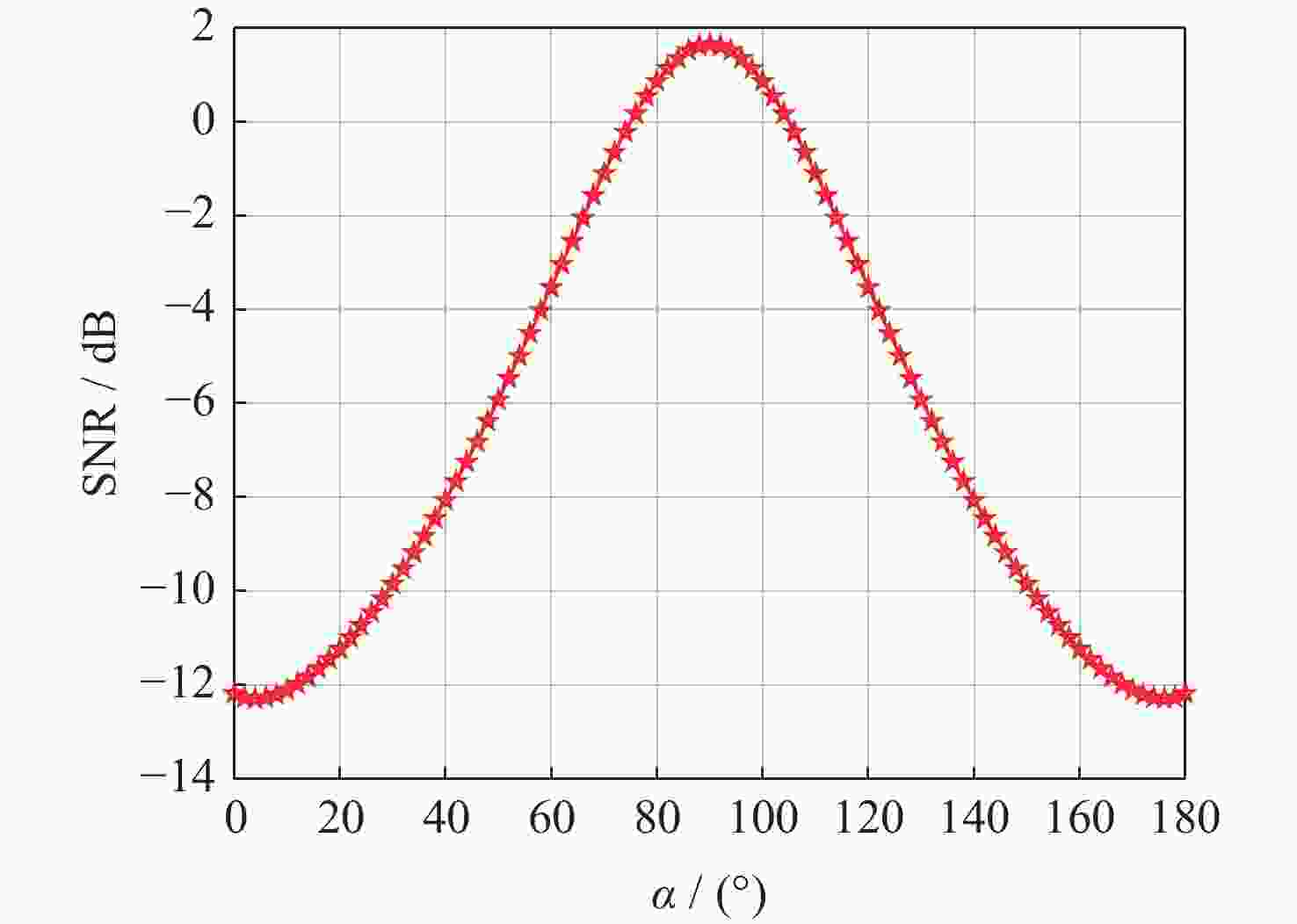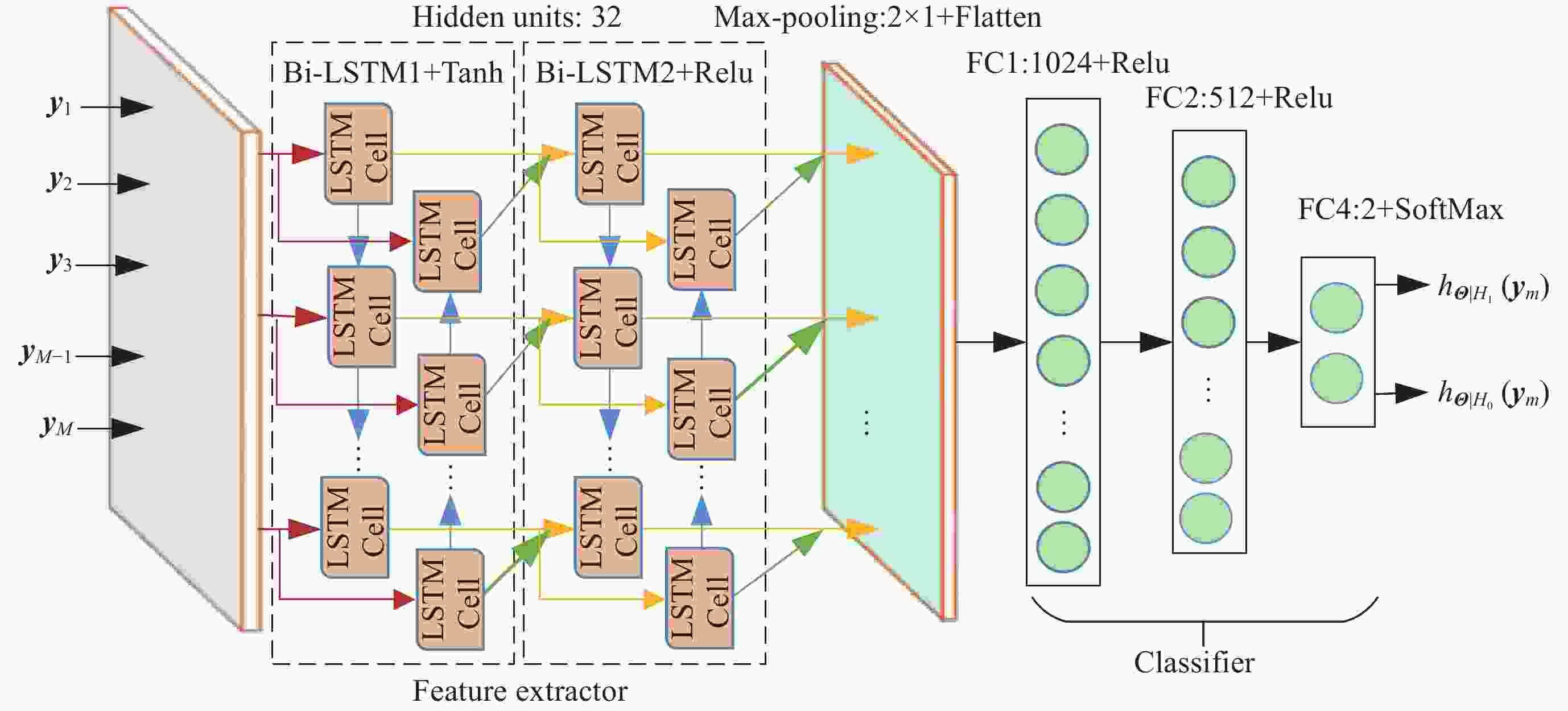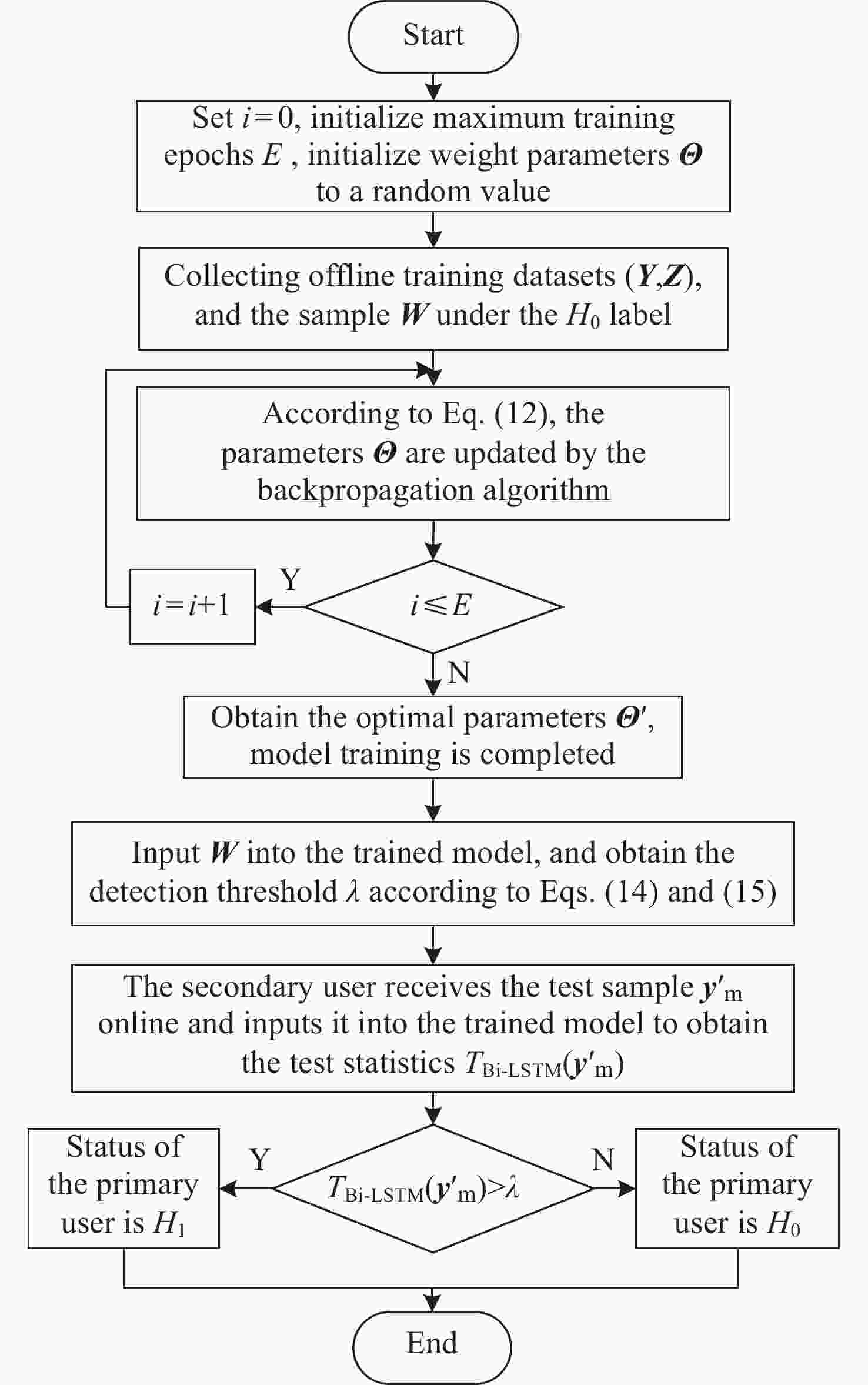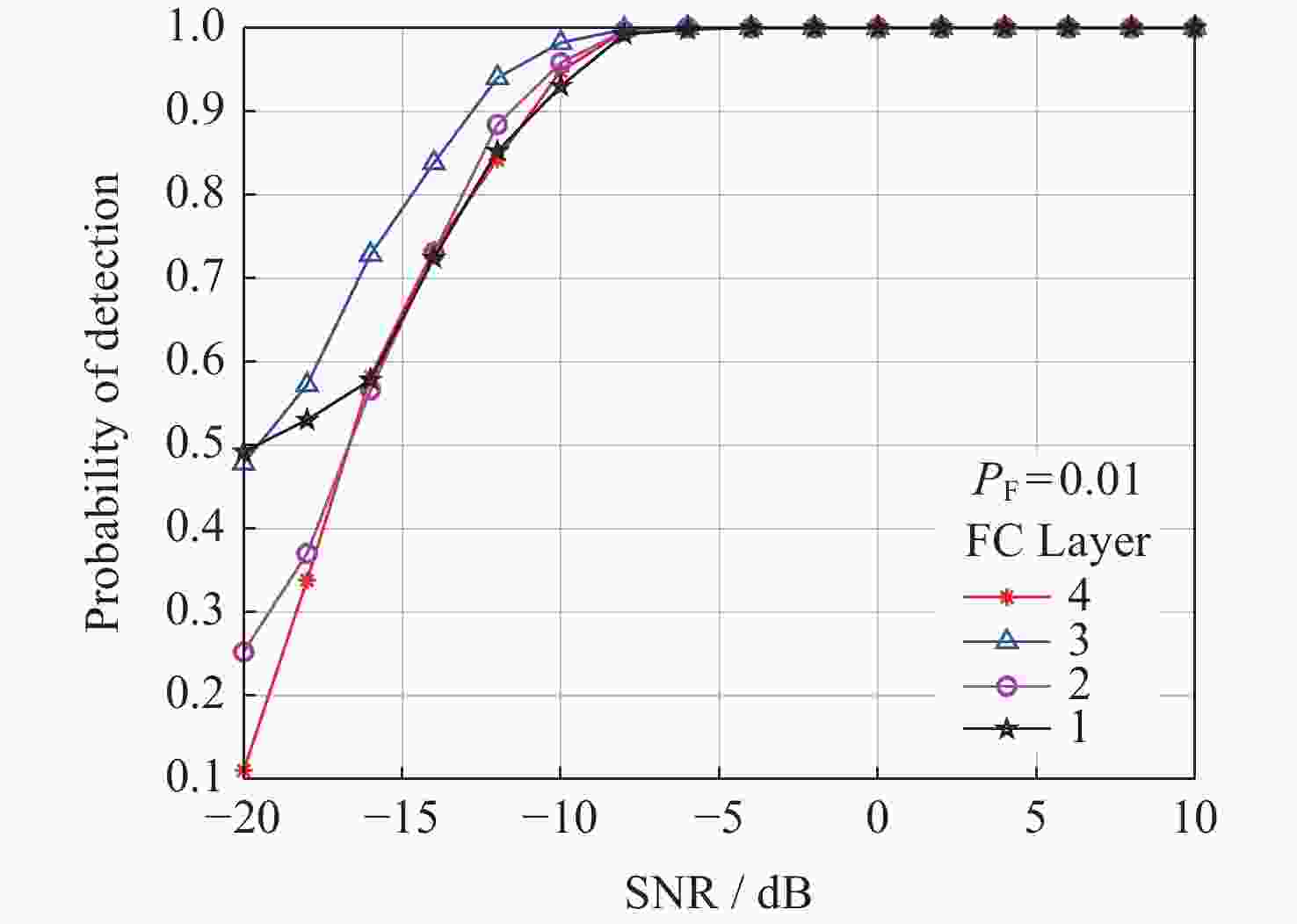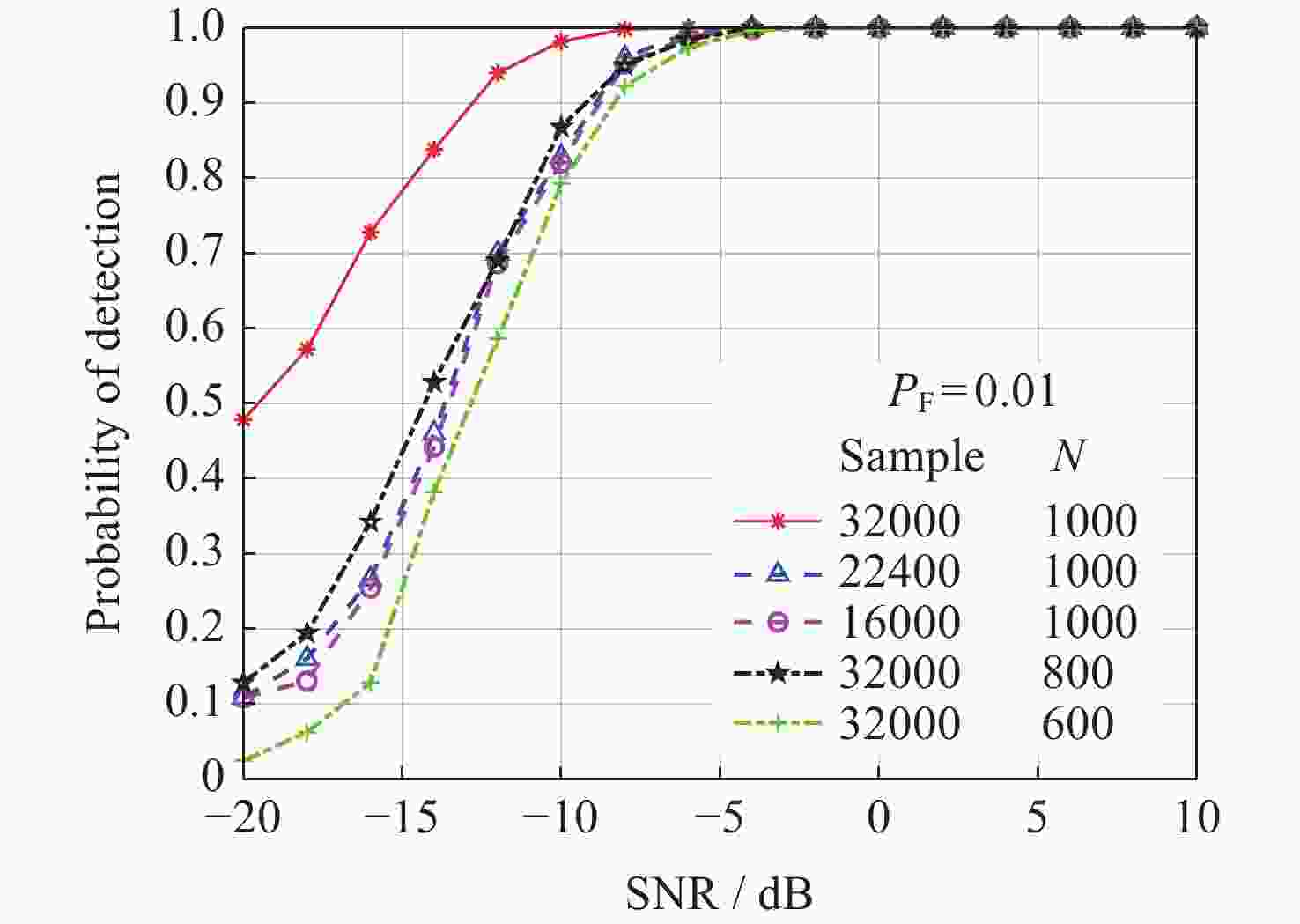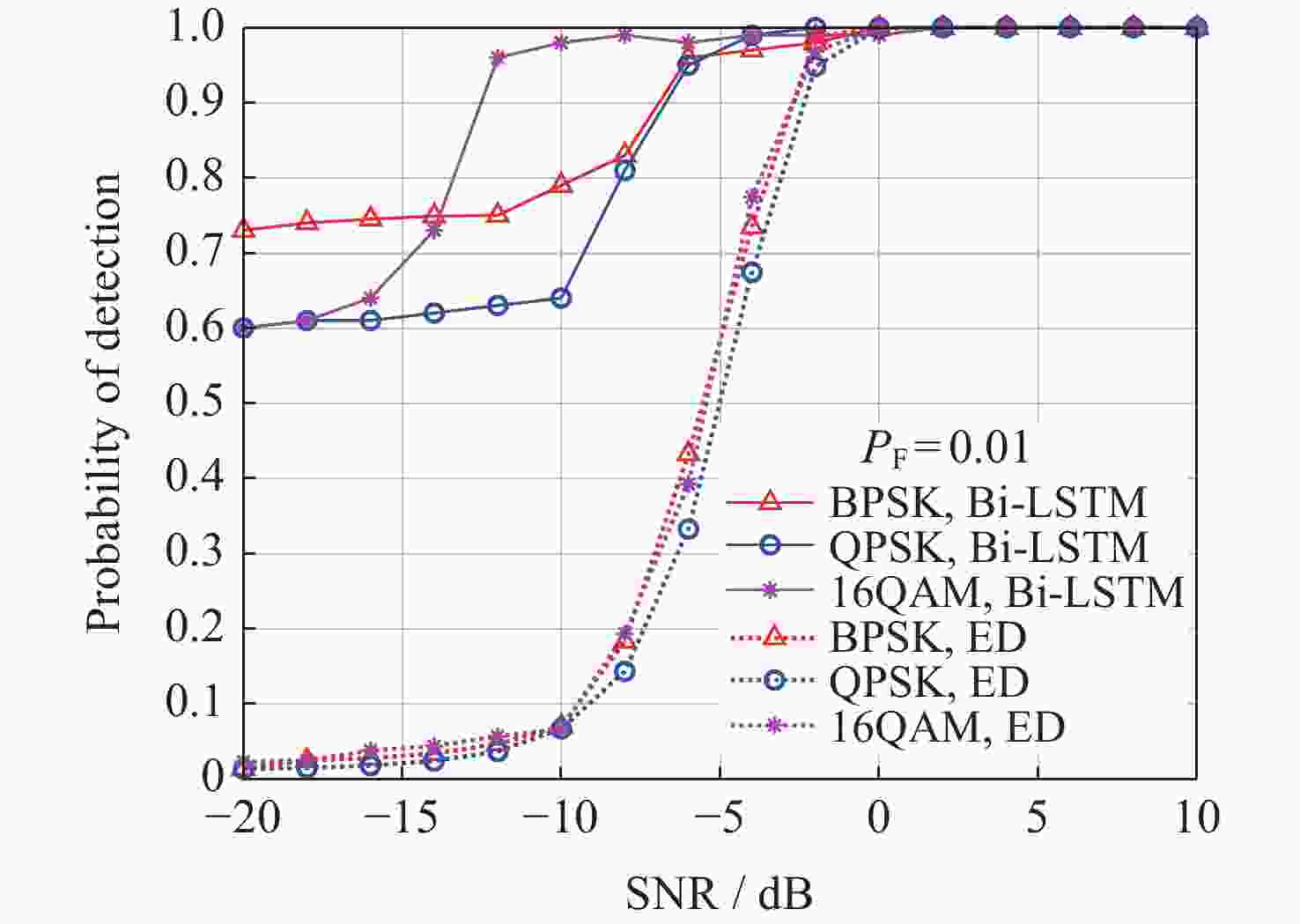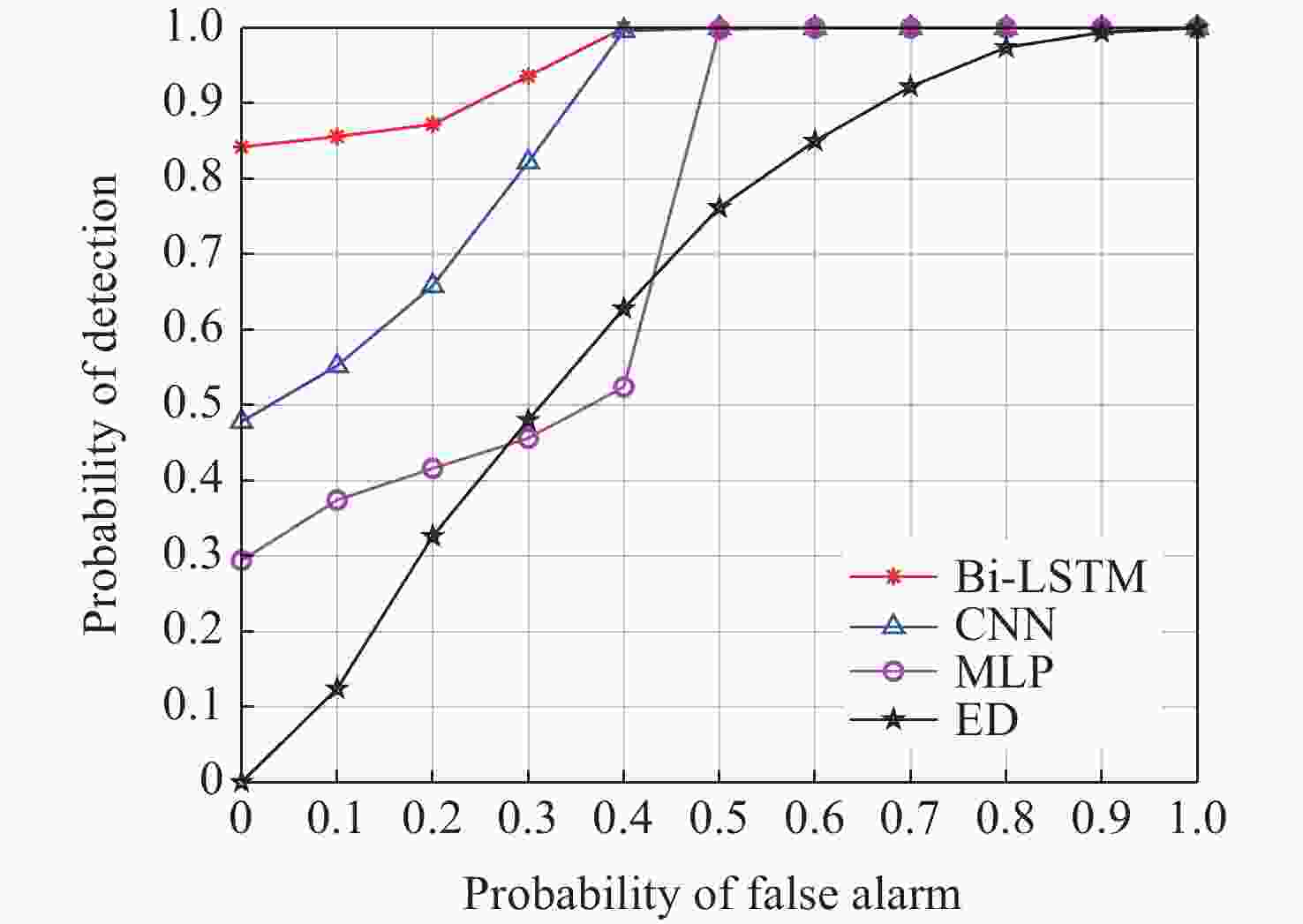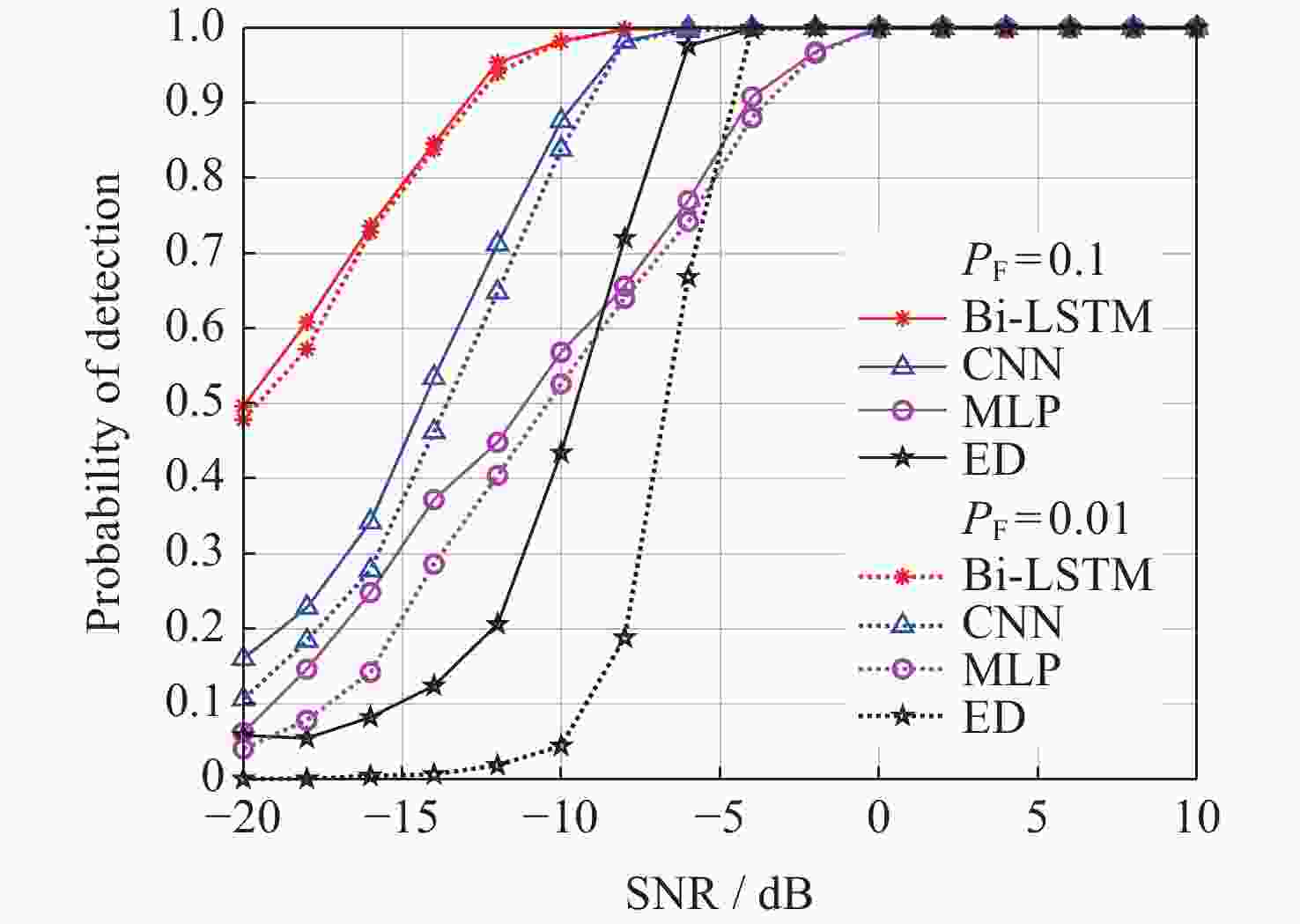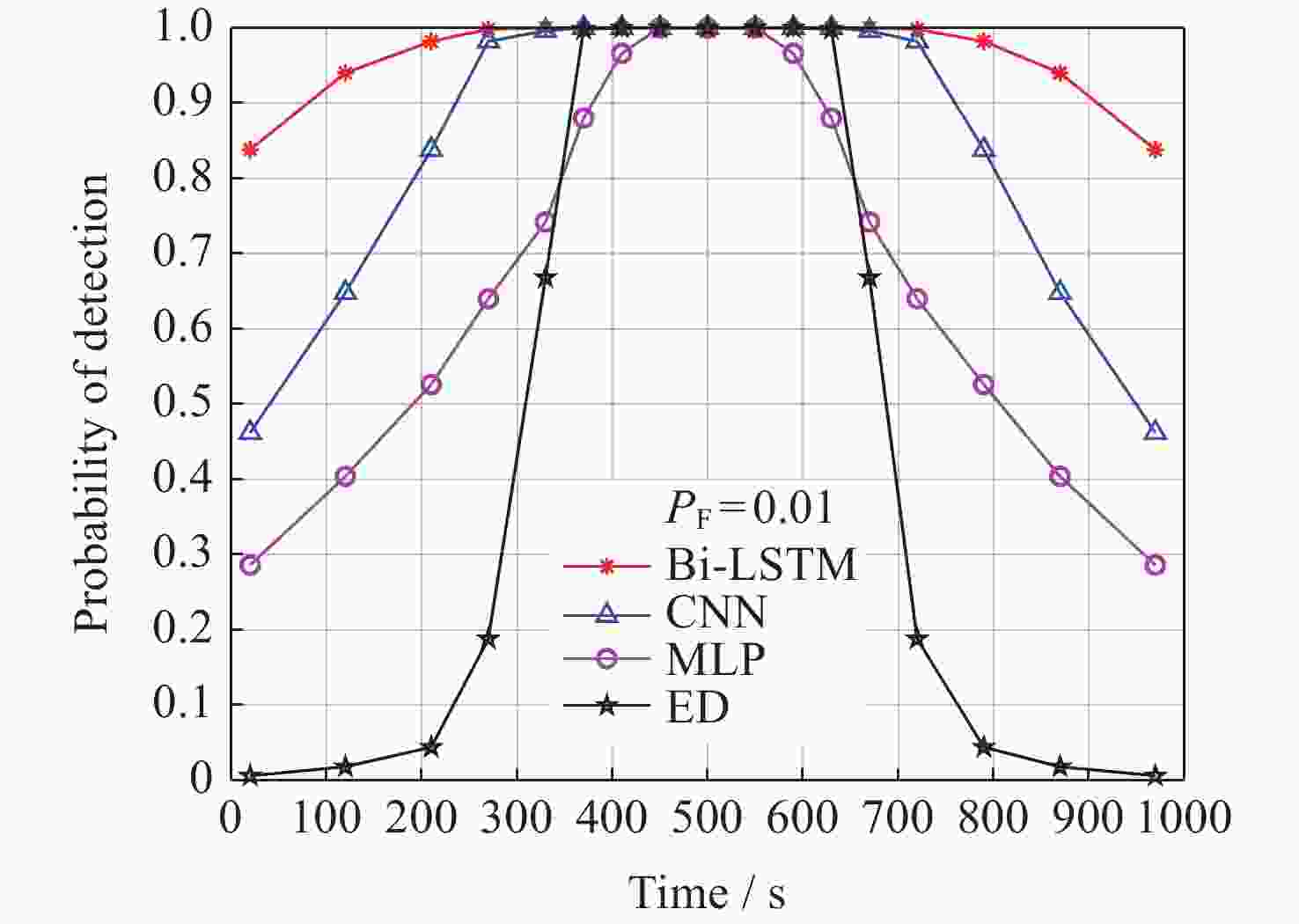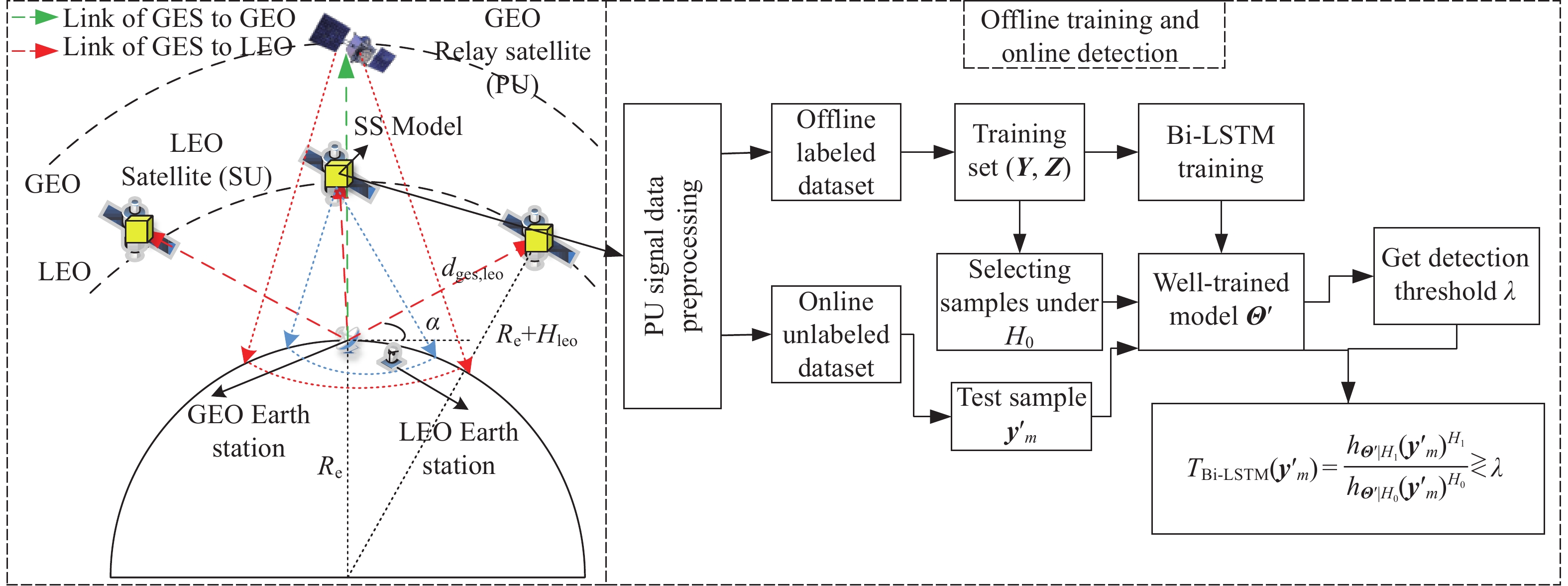基于Bi-LSTM及贝叶斯似然比检验的GEO与LEO卫星组合频谱感知
doi: 10.11728/cjss2023.03.2022-0017 cstr: 32142.14.cjss2023.03.2022-0017
Spectrum Sensing for Combined GEO and LEO Satellites Based on Bi-LSTM and Bayesian Likelihood Ratio Test
-
摘要: 目前的频谱感知算法以模型驱动为主,其感知性能过于依赖预定的统计模型,这使得其在信道环境复杂的卫星通信场景中的部署变得困难。对LEO卫星过境期间的信噪比波动情况进行分析,结果显示信噪比的波动达到14 dB。针对该复杂场景提出了一种基于双向长短期记忆网络及贝叶斯似然比检验联合的频谱感知算法。该算法不需要任何主信号的先验知识,可自动从主信号中学习隐藏特征并做出决策。基于Neyman-Pearson准则,在神经网络输出端设计了一种基于阈值的检测方案,可方便地控制恒定的虚警概率。仿真结果表明,所提算法在信噪比为–14 dB的情况下,仍能达到83%的检测性能,且始终优于卷积神经网络、多层感知机和基于模型驱动的能量检测算法。Abstract: With LEO mega satellite constellations coming into operation, the available spectrum resources are more crowded. To improve spectrum utilization, the cognitive satellite communication network composed of GEO relay satellites and LEO satellites has become one of the important candidate technologies to solve the above problem. In this scenario, LEO satellites are permitted to access the authorized spectrum of the GEO satellites through spectrum sensing technology. To avoid interferences from secondary users, spectrum sensing, which is used to quickly determine the presence or absence of primary users, is the most critical step in the scenario of cognitive satellite communication. Since most current spectrum sensing algorithms are model-driven, they rely heavily on the predetermined statistical model for their detection performance, which makes it more difficult to be modeled and deployed in satellite communication scenarios with complex channel environments. In this paper, we first analyze the fluctuation of the Signal-to-Noise Ratio (SNR) at the LEO satellite’s receiving end with the satellite-to-ground link loss model. The results show that the SNR’s fluctuation reaches 14 dB during satellite transit. Secondly, in this complex channel environment, a spectrum sensing algorithm combining a Bidirectional Long Short-Term Memory (Bi-LSTM) network and a Bayesian likelihood ratio test is proposed. The algorithm can automatically learn hidden features from the primary user signals and make final decisions without requiring any prior knowledge of the primary user signals. Additionally, according to the Neyman-Pearson criterion, we design a threshold-based detection mechanism at the output of the Bi-LSTM network, which can conveniently control the false alarm probability. Finally, the simulation results show that even with an SNR of –14 dB, the proposed algorithm achieves an excellent detection performance of 83% and always outperforms convolutional neural networks, multilayer perceptrons, and model-driven energy detection algorithms.
-
表 1 仿真参数
Table 1. Simulation parameters
参数名 值 调制类型 GMSK GES发送功率$ P_{{\text{ges}}}^{\text{t}} $/dBm 40 LEO接收机噪声温度$ {T_{{\text{leo}}}} $/K 175 GES发送天线增益$ G_{{\text{ges}}}^{\text{t}} $/dB 30 LEO接收天线增益$ G_{{\text{leo}}}^{\text{r}} $/dB 10 工作频率$ f $/GHz 29.9 带宽$ B $/MHz 24 大气吸收传播因子$ {A_{\text{g}}} $/dB 0.75 云雾衰减传播因子$ {A_{\text{c}}} $/dB 1.25 训练轮数 20 损失函数 Cross entropy loss 优化器 Adam 训练集样本数 32000 验证集样本数 3200 测试集样本数 8000 -
[1] YOU X H, WANG C X, HUANG J, et al. Towards 6 G wireless communication networks: vision, enabling technologies, and new paradigm shifts[J]. Science China Information Sciences, 2021, 64(1): 110301 doi: 10.1007/s11432-020-2955-6 [2] LIU R, ZHU S B, LI C Q. Review of cognitive satellite communication technology[C]//2020 IEEE 9 th Joint International Information Technology and Artificial Intelligence Conference (ITAIC). Chongqing: IEEE, 2020: 1378-1385 [3] LIU C, LIU X M, LIANG Y C. Deep CNN for spectrum sensing in cognitive radio[C]//ICC 2019 - 2019 IEEE International Conference on Communications (ICC). Shanghai: IEEE, 2019: 1-6 [4] NI T, DING X J, WANG Y F, et al. Spectrum sensing via temporal convolutional network[J]. China Communications, 2021, 18(9): 37-47 doi: 10.23919/JCC.2021.09.004 [5] TIAN J J, PEI Y Y, HUANG Y D, et al. Modulation-constrained clustering approach to blind modulation classification for MIMO systems[J]. IEEE Transactions on Cognitive Communications and Networking, 2018, 4(4): 894-907 doi: 10.1109/TCCN.2018.2879370 [6] JIANG C X, ZHANG H J, REN Y, et al. Machine learning paradigms for next-generation wireless networks[J]. IEEE Wireless Communications, 2017, 24(2): 98-105 doi: 10.1109/MWC.2016.1500356WC [7] CLANCY C, HECKER J, STUNTEBECK E, et al. Applications of machine learning to cognitive radio networks[J]. IEEE Wireless Communications, 2007, 14(4): 47-52 doi: 10.1109/MWC.2007.4300983 [8] HAN D, SOBABE G C, ZHANG C J, et al. Spectrum sensing for cognitive radio based on convolution neural network[C]//2017 10 th International Congress on Image and Signal Processing, BioMedical Engineering and Informatics (CISP-BMEI). Shanghai: IEEE, 2017: 1-6 [9] THILINA K M, CHOI K W, SAQUIB N, et al. Machine learning techniques for cooperative spectrum sensing in cognitive radio networks[J]. IEEE Journal on Selected Areas in Communications, 2013, 31(11): 2209-2221 doi: 10.1109/JSAC.2013.131120 [10] TANG Y J, ZHANG Q Y, LIN W. Artificial neural network based spectrum sensing method for cognitive radio[C]//2010 6 th International Conference on Wireless Communications Networking and Mobile Computing (WiCOM). Chengdu: IEEE, 2010: 1-4 [11] ZHANG M, DIAO M, GUO L M. Convolutional neural networks for automatic cognitive radio waveform recognition[J]. IEEE Access, 2017, 5: 11074-11082 doi: 10.1109/ACCESS.2017.2716191 [12] WANG J, TANG J, XU Z Y, et al. Spatiotemporal modeling and prediction in cellular networks: a big data enabled deep learning approach[C]//IEEE INFOCOM 2017 - IEEE Conference on Computer Communications. Atlanta: IEEE, 2017: 1-9 [13] SHAWEL B S, WOLDEGEBREAL D H, POLLIN S. Convolutional LSTM-based long-term spectrum prediction for dynamic spectrum access[C]//2019 27 th European Signal Processing Conference (EUSIPCO). A Coruna: IEEE, 2019: 1-5 [14] WU T. CNN and RNN-based deep learning methods for digital signal demodulation[C]//Proceedings of the 2019 International Conference on Image, Video and Signal Processing. Shanghai: Association for Computing Machinery, 2019: 122-127 [15] XIE J D, FANG J, LIU C, et al. Deep learning-based spectrum sensing in cognitive radio: a CNN-LSTM approach[J]. IEEE Communications Letters, 2020, 24(10): 2196-2200 doi: 10.1109/LCOMM.2020.3002073 [16] GIUFFRIDA G, DIANA L, DE GIOIA F, et al. CloudScout: a deep neural network for on-board cloud detection on hyperspectral images[J]. Remote Sensing, 2020, 12(14): 2205 doi: 10.3390/rs12142205 [17] LI F L, LI Z Q, LI G X, et al. Efficient wideband spectrum sensing with maximal spectral efficiency for LEO mobile satellite systems[J]. Sensors, 2017, 17(1): 193 [18] ZHANG C, JIANG C X, JIN J, et al. Spectrum sensing and recognition in satellite systems[J]. IEEE Transactions on Vehicular Technology, 2019, 68(3): 2502-2516 doi: 10.1109/TVT.2019.2893388 [19] SENGIJPTA S K. Fundamentals of statistical signal processing: estimation theory[J]. Technometrics, 1995, 37(4): 465-466 [20] ZHENG S L, CHEN S C, QI P H, et al. Spectrum sensing based on deep learning classification for cognitive radios[J]. China Communications, 2020, 17(2): 138-148 doi: 10.23919/JCC.2020.02.012 [21] SAEED N, ELZANATY A, ALMORAD H, et al. CubeSat communications: recent advances and future challenges[J]. IEEE Communications Surveys & Tutorials, 2020, 22(3): 1839-1862 [22] O’SHEA T J, WEST N. Radio machine learning dataset generation with GNU radio[C]//Proceedings of the 6 th GNU Radio Conference. Boulder: GRCon, 2016 -
-






 下载:
下载:
